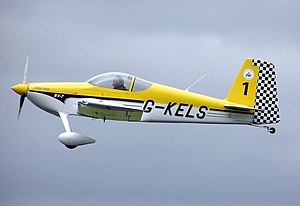Van's Aircraft RV-7
| RV-7 | |
|---|---|

| |
| Role | RV-7 |
| Manufacturer | Van's Aircraft |
| Designer | Richard VanGrunsven |
| First flight | 2001[1] |
| Introduction | 2001 |
| Number built | 1785 (October 2019)[2] |
| Developed from | Van's Aircraft RV-6 |



The Van's RV-7 and RV-7A are two-seat, single-engine, low-wing homebuilt airplanes sold in kit form by Van's Aircraft. The RV-7 is the tail-wheel equipped version, while the RV-7A features a nose-wheel.[3]
The RV-7 was the replacement of the RV-6, replacing the RV-6 in 2001.[4] It is externally similar to the earlier model, with longer wings, larger fuel tanks and a larger rudder to improve spin recovery characteristics.[5]
Development
Van's aircraft designer Richard VanGrunsven designed the RV-7 to replace the RV-6, which was a two-seat side-by-side development of the RV-4. In turn, this was a two-seat version of the single seat RV-3.[6]
The RV-7 incorporated many changes resulting from the lessons learned in producing over 2,000 RV-6 kits. The RV-7 airframe will accept larger engines, including the Lycoming IO-390, up to 210 hp (157 kW).[7] The RV-7 also has increased wingspan and wing area over the RV-6, as well as more headroom, legroom and an increased useful load. The RV-7 carries a total of 42 US gallons (159 litres) of fuel, up from 38 US gallons (144 litres) on the RV-6.[6]
The RV-7 shares many common parts with the RV-8 and RV-9, which reduces production costs. The RV-7 has a computer-assisted design with pre-punched rivet holes, helping to keep assembly time to about 1500 hours for the average builder.[8]
The RV-7A version features a hardened, solid steel nose-wheel strut that fits into a tube welded to the engine mount. As in all nose-wheel equipped RV aircraft, the nose-wheel is free castering and the aircraft is steered with differential braking, or rudder at higher taxi speeds. The brakes are conventional toe brakes.
As of October 2019, 1,785 RV-7s and RV-7As had been flown.[2]
Pricing
As of December 2016, the price of the "standard build" RV-7 kit was US$22,910 and the "quick-build" kit US$34,350.[9]
In 2008, Van's claimed that most builders can complete their RV-7 projects for between US$41,000 – $97,000.[8] In 2016, Van's estimated the completion cost at between US$55,500 and US$116,000. However, Van's cautioned these numbers were estimates only, as costs vary significantly based on installed equipment and finishing.[10]
Specifications (RV-7)
Specifications are given for 200 hp, IO-360 configuration with a Hartzell constant speed propeller
General characteristics
- Crew: one pilot
- Capacity: one passenger
- Length: 20 ft 4 in (6.20 m)
- Wingspan: 25 ft (7.6 m)
- Height: 5 ft 10 in (1.79 m)
- Wing area: 121 sq ft (11.2 m2)
- Empty weight: 1,114 lb (505 kg)
- Gross weight: 1,800 lb (816 kg)
- Max takeoff weight: 1,800 lb (816 kg)
- Powerplant: 1 × Lycoming O-320, Lycoming O-360 or Lycoming IO-390 constant speed or fixed pitch, 160 to 210 hp (120 to 160 kW)
Performance
- Maximum speed: 217 mph (349 km/h, 189 kn) at sea level
- Cruise speed: 207 mph (333 km/h, 180 kn)
- Stall speed: 51 mph (82 km/h, 44 kn)
- Never exceed speed: 230 mph (370 km/h, 200 kn)
- Range: 765 mi (1,231 km, 665 nmi) at cruise 75% power at 8,000 ft (2,500 m)
- Service ceiling: 22,500 ft (6,900 m)
- Rate of climb: 1,900 ft/min (9.7 m/s)
- Wing loading: 14.8 lb/sq ft (72 kg/m2)
See also
Related development
Aircraft of comparable role, configuration, and era
References
- ^ Van's Aircraft (2008). "Introduction – About RV Kitplanes". Archived from the original on 2012-03-09. Retrieved 2008-09-21.
- ^ a b Vans Aircraft (October 2019). "First Flights". Retrieved 18 October 2019.
- ^ Vandermeullen, Richard: 2011 Kit Aircraft Buyer's Guide, Kitplanes, Volume 28, Number 12, December 2011, page 74. Belvoir Publications. ISSN 0891-1851
- ^ Vans Aircraft (April 2019). "Van's RV-6 / 6A". Retrieved 13 April 2019.
- ^ Vans Aircraft (June 2002). "Service Bulletin SB02-6-1" (PDF). Retrieved 2013-08-04.
- ^ a b Bayerl, Robby; Martin Berkemeier; et al: World Directory of Leisure Aviation 2011–12, page 125. WDLA UK, Lancaster UK, 2011. ISSN 1368-485X
- ^ "Van's RV-7". Van's Aircraft. Retrieved 27 September 2020.
- ^ a b Kitplanes Staff: 2008 Kit Aircraft Directory, page 77, Kitplanes Magazine December 2007 Volume 24, Number 12, Belvior Publications, Aviation Publishing Group LLC.
- ^ Van's Aircraft (December 2016). "Kit Prices and Lead Times". Retrieved 2016-12-15.
- ^ Van's Aircraft (December 2016). "Cost Estimator". Retrieved 2016-12-15.
